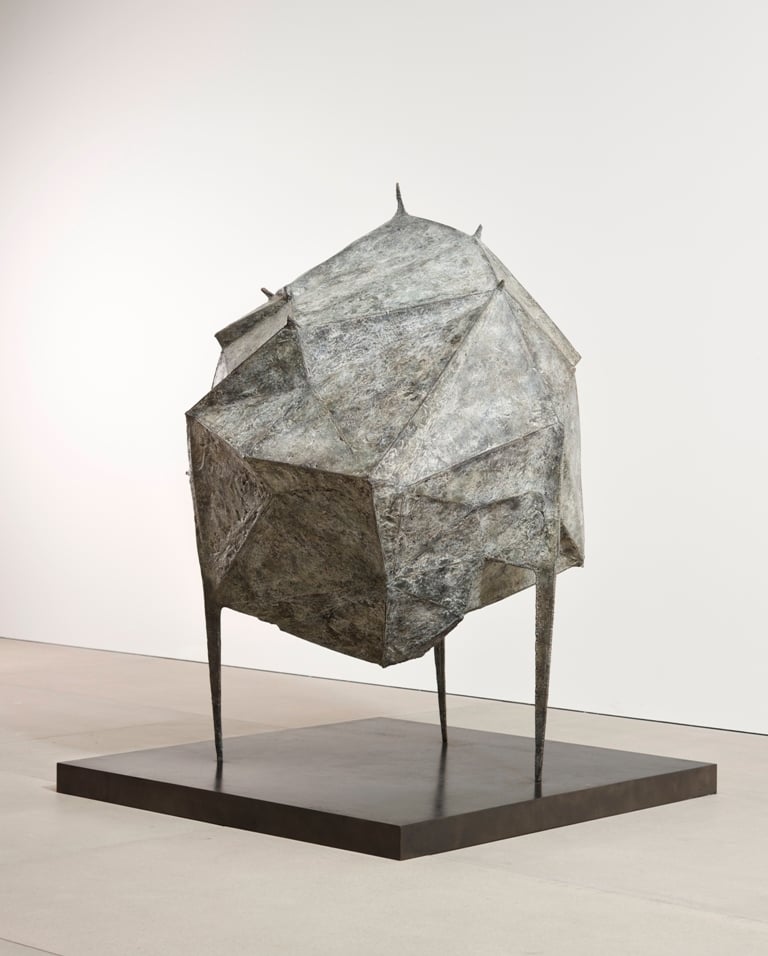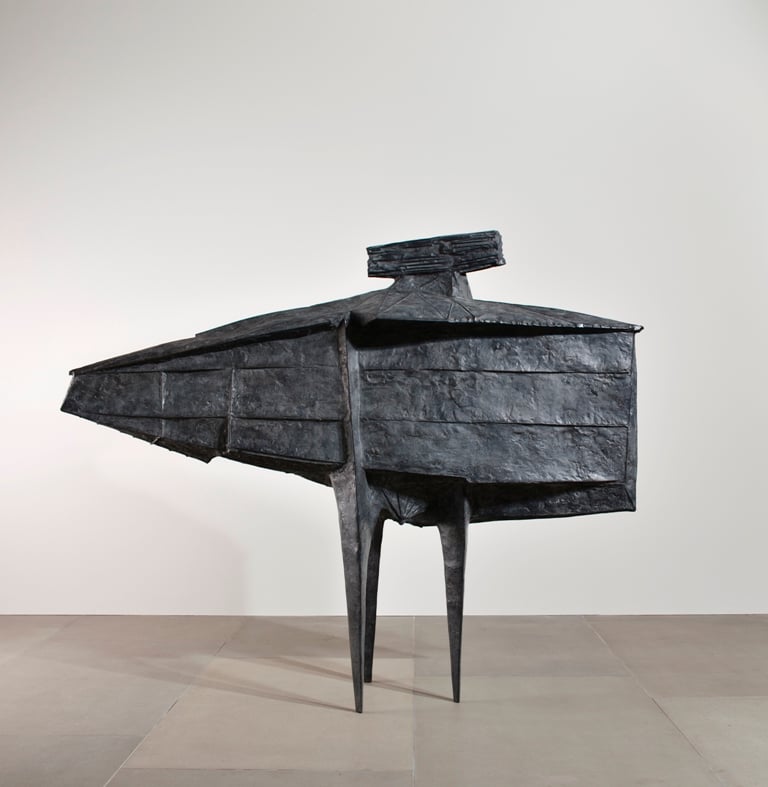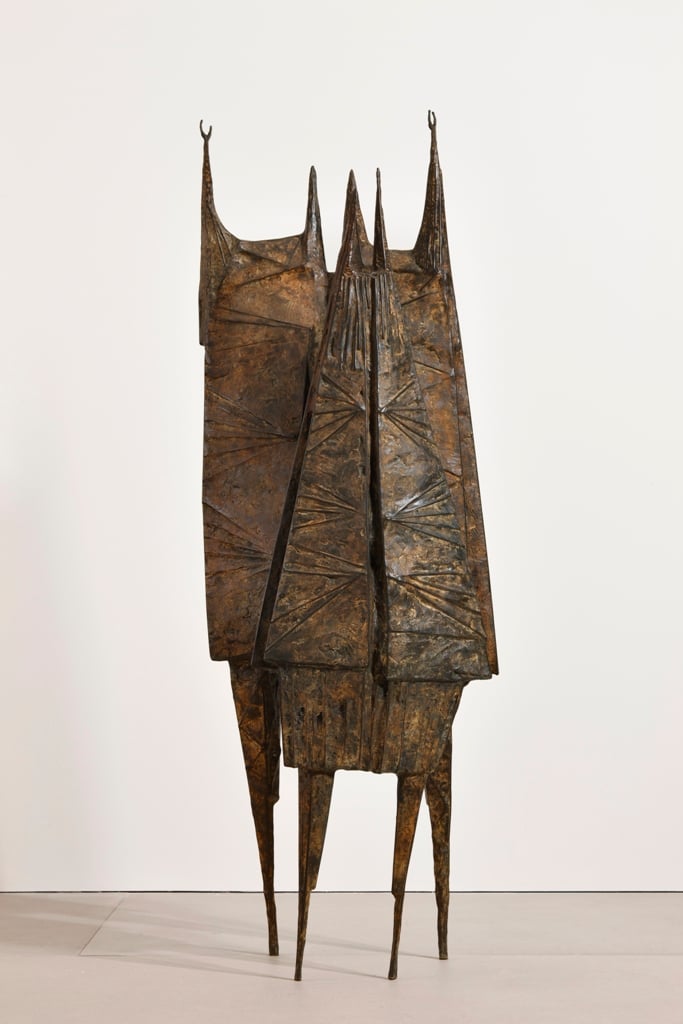Analysis
Is Lynn Chadwick Set to Storm the Art Market?
The late modern sculptor's works are now highly sought after.

The late modern sculptor's works are now highly sought after.


Lynn Chadwick, Stranger III (1959)
Photo: Peter Mallet, 2014.
Image: © The Chadwick Estate and courtesy of the Chadwick Estate and Blain Southern.
When Lynn Chadwick won the International Sculpture Prize at the 1956 Venice Biennale, he beat Alberto Giacometti. It felt “rather like the girl being told that she’s Miss World,” later commented the artist, whose centenary is celebrated this year with several shows, a new monograph by Michael Bird, and an updated catalogue raisonné. At the time of the prize, the British artist had only started sculpting six years previously, moving from mobiles to spindly constructions of welded steel rods filled with a mixture of iron and plaster. He was the youngest artist to receive the accolade, and did so to much acclaim. The prize seemed to set Chadwick on the path to a stratospheric career.
But the artist, who died in 2003, felt he never truly got the critical reception he deserved—and this, despite being collected on a global scale from the mid-1950s onwards. Talking to artnet News, Rene Gimpel from the London gallery Gimpel Fils, which gave Chadwick his first solo show in 1950, remembers how, late in his career, the artist “felt estranged from the art world and lamented the lack of attention by younger critics.” Perhaps it had to do with his fairly recluse life at the country estate of Lypiatt Park, in Gloucestershire, which he bought in 1958 and spent decades restoring and transforming, away from the limelight. Perhaps it had to do with his rather private personality, not always easy to approach for commissions.
Chadwick had debuted on the global stage four years before the sculpture prize, with the exhibition “New Aspects of Sculpture,” held at the British pavilion in Venice in 1952. It gathered a generation of sculptors that captured postwar Britain’s existentialist angst: Chadwick as well Reg Butler, Eduardo Paolozzi, William Turnbull, and Kenneth Armitage, among others. Famously described by critic Herbert Read (quoting T.S. Eliot) as “the geometry of fear,” the show was a groundbreaking success. While Chadwick might be described as the best-known of the group, he did not became a household name on a par with his illustrious predecessors Henry Moore and Barbara Hepworth, or with his junior, the radical innovator Anthony Caro.

Lynn Chadwick, Moon of Alabama (1957)
Photo: Peter Mallet, 2014.
Image © The Chadwick Estate, and courtesy of the Chadwick Estate and Blain Southern.
Data available on artnet Analytics show that the secondary market reflects this discrepancy. For most artists, the towering figure of Moore is difficult to match (Moore’s auction record is $30,316,571, achieved in 2012 with his Reclining Figure: Festival, conceived in 1951), but the Chadwick market is also much less buoyant that Hepworth’s. His record of $1,864,000 was set in 2006 with the bronze Couple on a Seat (1984), significantly less than the $3,604,412 Hepworth achieved with Curved Form (Bryher II) (1961) in 2013. Caro’s record is also markedly higher than Chadwick’s: his 1962 Sculpture Two sold for $2,455,956 in 2006. “For Chadwick and Caro, there will have to be a longer time gap,” says Gimpel, comparing the younger artists to Moore and Hepworth.
Things could change quickly, though. Blue chip gallery Blain Southern and its sister gallery Blain Di Donna took on the Chadwick estate last year and are using the opportunity afforded by the centenary to “reposition Chadwick,” to borrow the words of Blain Southern director Adrian Sutton. The Royal Academy is currently showing four late angular metal beasts in its courtyard in association with the London gallery. And the largest ever Chadwick exhibition, spanning both Blain Southern galleries in London and Berlin, as well as Blain Di Donna in New York, is opening this month, beginning May 1 in the British capital.
“With Lynn’s market, people think they know the work well, whereas in fact they probably know only a very distinct period of his career,” Sutton told artnet News. Gathering exclusively pieces consigned from the estate, the global exhibition maps the artist’s entire production from the 1950s to the mid-1990s, when he chose to stop working. The London leg of the retrospective focuses on the early period of Chadwick’s work, including ghostly figures such as Teddy Boy and Girl (1955), or the large Stranger III (1959), whose body seem to fuse human and machine, and some of his rarely shown Formica works from 1966.

Lynn Chadwick, Teddy Boy and Girl (1955)
Photo: Peter Mallet, 2014.
Image © The Chadwick Estate, and courtesy of the Chadwick Estate and Blain Southern.
The Chadwick estate is a timely addition to the gallery’s roster. The artist’s market has been very dynamic in recent years: the volume increased from $1,170,767 in 2003, the year of the artist’s death, to $4,764,296 in 2013. It’s also been relatively liquid. Barring 2008 and 2009, at the peak of the recession, the sell-through rate has been consistently above 70 percent, with a large number of lots hitting the auction block every year. In 2013, for instance, 99 Chadwick works appeared at auction, against only 36 Hepworths, and 18 Caros.
Although operating on a primary market model working directly with the estate, Blain Southern’s Sutton has identified a strong potential for more of Chadwick’s works than the large figurative bronzes popular at auction. “I think it’s fair to say that he was forgotten,” he says. “Yes, his career didn’t go in the same way as Giacometti’s, but that’s what we are trying to readdress.”
“Forgotten” might be a slight overstatement. When he died in 2003, the artist was working on a major retrospective at Tate Britain, which opened in September that year. His work is to be found in a vast number of public collections, including the Centre George Pompidou, the Museum of Modern Art, and Moderna Museet. The artist’s work has been shown every single year since 1952.
This constant exposure, not always of the best kind, might in fact be part of the reason why he somewhat fell out of fashion. Gimpel told artnet News: “My own view is that his pursuit of a rather ostentatiously materialist lifestyle at some point probably distanced him from the concerns of other artists of his generation. As he said in conversation, ‘No home in Scandinavia or in South America is without a Chadwick’; but the irony of this was not lost on him, because it did not bring him back to public notoriety and recognition of the sort that had won him kudos so early in his career.”
Gimpel added, “Perhaps there was too much recycling of earlier motifs, rather than a steady development, and where this was the case, too much casting.”
It was Chadwick’s widow, Éva Chadwick, who approached Blain Southern and Blain Di Donna. Her move could be interpreted as an attempt to tighten the control of the artist’s posthumous production. But this won’t mean less casting. Indeed, Chadwick left precise instructions about the casting of his pieces after his death. They are to be executed by Pangolin Editions under the supervision of Rungwe Kingdon and Claude Koenig, who have been responsible for Chadwick’s casts since the early 1980s. “Pangolin have the legal and the moral authority, and right,” to cast editions of the artist’s work which weren’t sold when he was alive, Sutton explained. The gallery told artnet News there won’t be any distinction, either in price nor description, between casts made during the artist’s lifetime or posthumously—although this could become apparent on the secondary market at a later stage.
While Chadwick’s average sale value at auction has yet to recover its pre-recession level, the steady growth in the artist’s market over the past two decades, now combined with a strong gallery management, is promising. One thing is certain: Chadwick’s work, and his market, are about to receive the kind of reassessment the artist long hoped for.